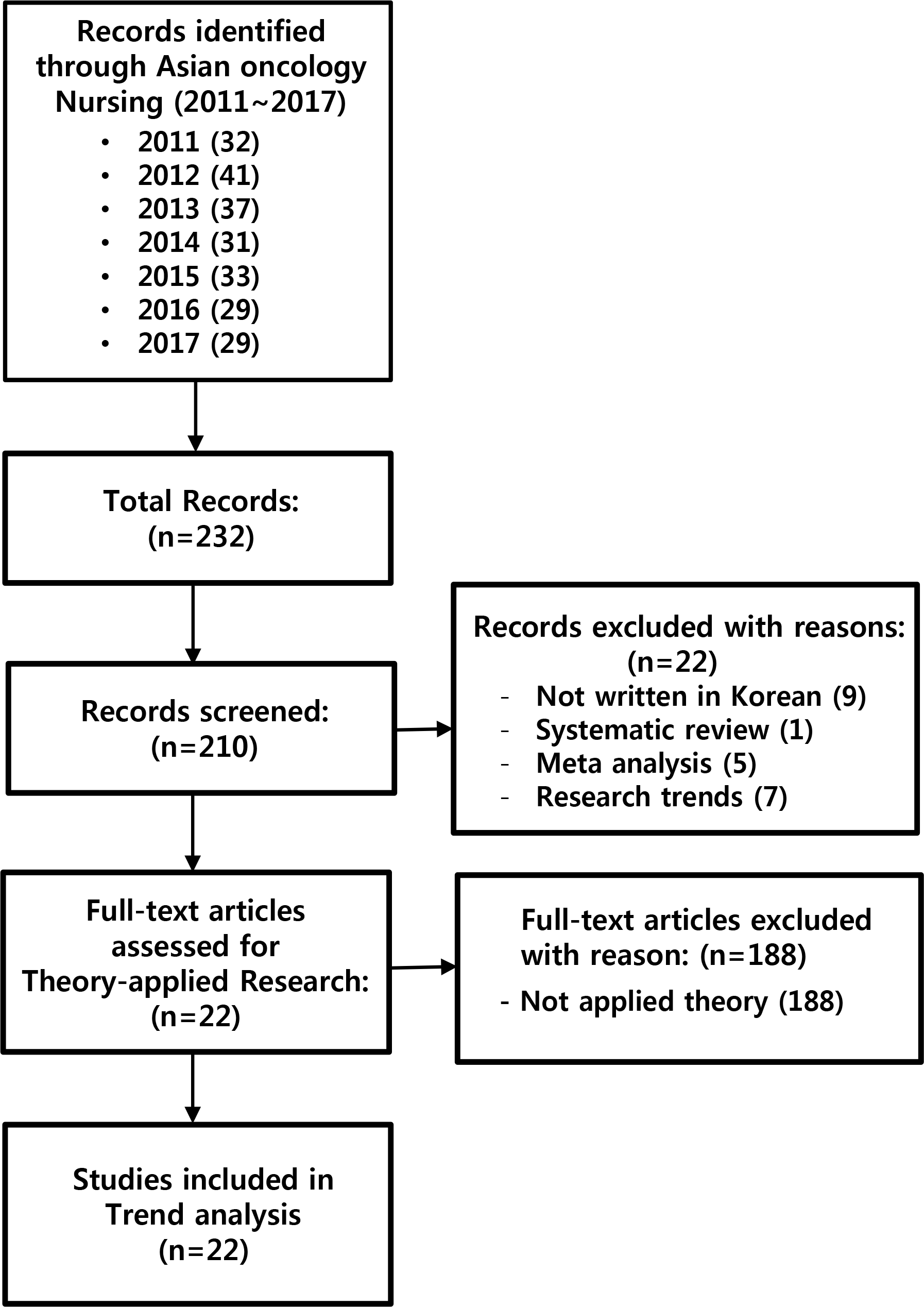초록
Purpose
This study was conducted to identify and analyze the trends of theory-based research published in Asian Oncology Nursing (AON) from 2011 to 2017.
Methods
We analyzed 22 theory-based studies taken from among the 232 studies published in AON for 7years. We analyzed the framework developed by researchers, descriptive summaries of theory, keyword classification of nursing me-ta-paradigms, the generic character of the studies, and the type of research designs.
Results
A total of 23 theories were applied in the 22 (9.5%) studies. ‘Nursing’ was the most prevalent field of study (34.8%). In the field of study of theory, nursing theory was the largest with eight (34.8%), and in the method of theory utilization, all 22 studies were theoretical applications 3 middle-range theories were most prevalent. In the keyword classification using meta-paradigm in nursing, we found 83 key words. Among them, ‘Health’ related key words were most frequent (53), followed by ‘Cancer’ keywords (13).
Go to : 
REFERENCES
1. Statistics Korea. 2015 annual report: cause of death [Internet]. Available from. http://kostat.go.kr. [Accessed October 24, 2018].
2. Centers for Disease Control and Prevention. Leading causes of death [Internet]. Available from. http://www.cdc.gov/nchs/fastats/lcod.htm. [Accessed October 24, 2018].3. Korean Oncology Nursing Society. Title [Internet]. Available from. http://www.kons.or.kr. [Accessed October 24, 2018].
4. Lim SO, Hong EY. An integrative review and metaanalysis of oncology nursing research: 1985-1997.2. J Nurs Acad Soc. 1997; 27:857–70.

5. Choi SH, Nam YH, Ryu EJ, Baek MW, Suh DH, Suh SR, et al. An integrative review of oncology nursing research: 1980-1998. J Korean Acad Nurs. 1998; 28:786–800.

6. Chung BY, Yi MS, Choi EH. Trends of nursing research in the Journal of Oncology Nursing. J Korean Oncol Nurs. 2008; 8:61–6.
7. Oh PJ. An integrative review of oncology nursing research in Korea: 1998-2003. J Korean Oncol Nurs. 2003; 3:112–21.
8. Oh PJ. An integrative review of oncology nursing research in Korea: 2003-2008. J Korean Oncol Nurs. 2010; 10:80–7.
9. Jun M, So HS, Choi KS, Chung BY, Ryu E, Lee DS, et al. Analysis of research papers published by three nursing journals to suggest the direc-tion of Journal of Korean Oncology Nursing. J Korean Oncol Nurs. 2011; 11:163–70.

10. Kim SH, Kim MY, Kim SH, Kim HK, Lee I, Lee J, et al. Trends of studies published in Asian Oncology Nursing, 2011~2014. Asian Oncol Nurs. 2015; 15:114–22.

11. Han NK, Kim S, Kim MS, Kim JG, Kim CH, Choi SH. Trend analysis of research in the Korean Journal of Adult Nursing for 5 years (2010~2014): focused on usage of nursing theories. Korean J Adult Nurs. 2015; 27:527–36.

12. Ji H, Hong S, Jeong YR, Lee KH. Analysis of theory-applied research in the Journal of Korean Academy of Nursing administration (2007~2016). J Korean Acad Nurs Adm. 2018; 24:130–8.

14. Nam K, Tae Y, Kim C, Lee S. Influence of uncertainty and uncertainty appraisal on quality of life in prostate cancer patients after prostatec-tomy. Asian Oncol Nurs. 2017; 17:45–54.

15. Kim KO, Kim JA. Influences of uncertainty and social support on the quality of life among elderly cancer patients. Asian Oncol Nurs.
Go to : 
Table 1.
General Characteristics of Studies Used in the Asia Oncology Nursing Last 7 Years (N =22)
Table 2.
General Characteristics of Theories Used in the Asia Oncology Nursing Last 7 Years (N= 22)
Table 3.
Descriptive Summary of Studies Guided by Theories (N =22)
Table 4.
Keyword Classification by Nursing Meta-paradigm (N = 22)




 PDF
PDF ePub
ePub Citation
Citation Print
Print



 XML Download
XML Download